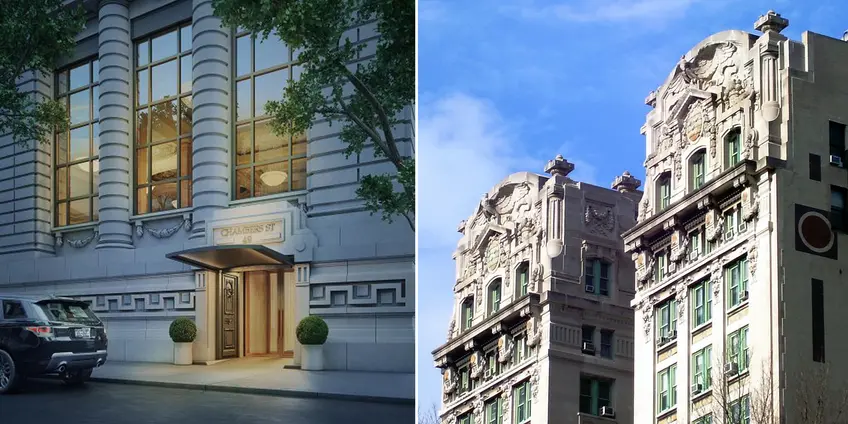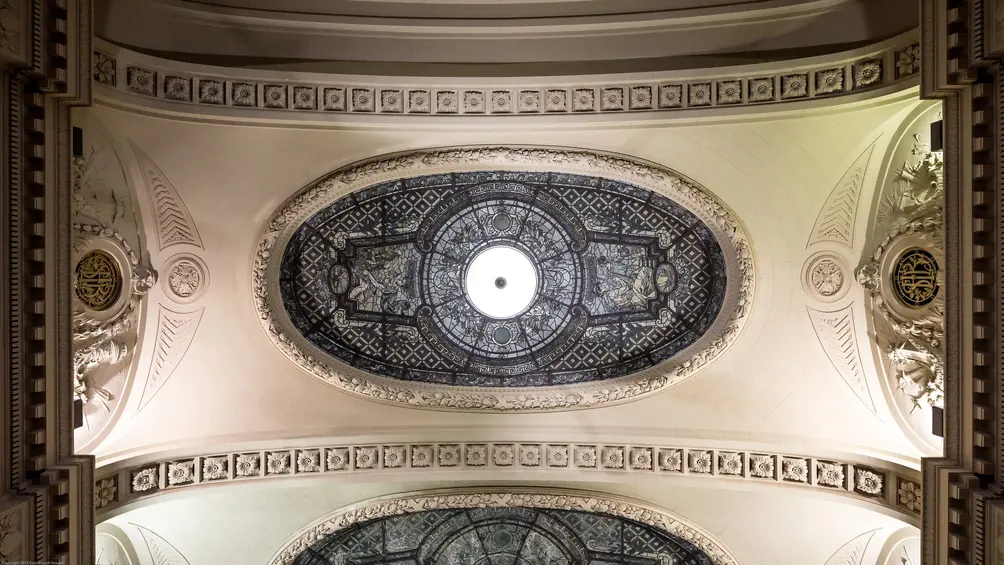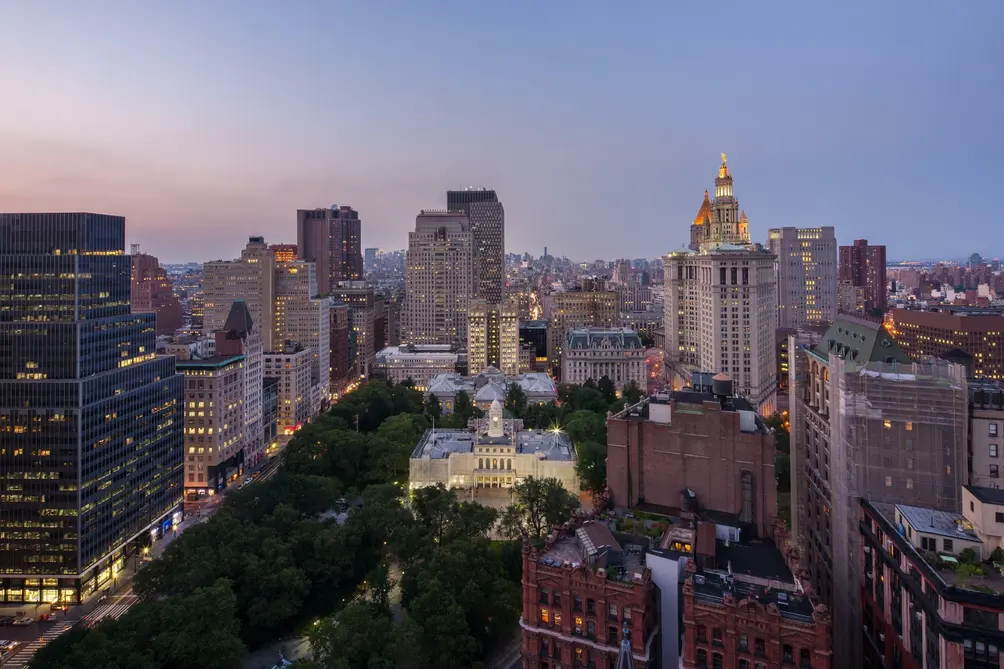 Rendering of entryway and crown detail of 49 Chambers
Rendering of entryway and crown detail of 49 Chambers
In a space-starved city of skyrocketing land and housing prices, converting existing commercial buildings into residential units is a growing trend. Besides the benefit of adding to the city's housing stock, historically significant structures get the chance to reclaim their former glory. A perfect example of this is the conversion of the Emigrant Industrial Savings Bank building at the junction of Tribeca, the Civic Center, and the Financial District.
The 200,000-square-foot Beaux-Arts behemoth, which developer Chetrit Group bought for $89 million in 2013, will now be rebranded as a condominium building simply addressed as 49 Chambers Street. The H-shaped building has long been considered an architectural landmark but both its exterior and first floor became officially designated in 1985. The official sales site went live yesterday, revealing a slew of interior renderings, and the project's exciting amenity package.
In this article:
The 14-story tower will forgo the offices it previously held, only to reserve the ground level for retail, and the newly-added condo interiors, designed by Gabellini Sheppard. Residences will have modern fishings which, while minimalistic, showcase the designer's aesthetic of functional luxury and complement the building's impeccable craftsmanship. The lobby, like the exterior, will maintain the building's moniker Beaux-Arts style while the interiors will receive a sophisticated yet contemporary upgrade.
Restoration is currently underway under the direction of international architecture firm Woods Bagot, and will include the intricate carvings, cornices, friezes and, per the press release, "the incredible beehive motif found throughout, a classic symbol of industry and creativity that was the icon of the Barberini family during the Italian Renaissance".
Restoration is currently underway under the direction of international architecture firm Woods Bagot, and will include the intricate carvings, cornices, friezes and, per the press release, "the incredible beehive motif found throughout, a classic symbol of industry and creativity that was the icon of the Barberini family during the Italian Renaissance".
 The Beaux-Arts ceiling
The Beaux-Arts ceiling
As we can see from the published renderings, the impeccably designed interiors use warm and earthy tones to complement the old glamour of the landmarked structure; accents of bronze, metal and mirror can be seen throughout the opulent residences which include custom hardwood flooring in a herringbone pattern, Roman-reminiscent bathrooms carved out of honed Ariel White marble, custom-designed double vanities in the bathrooms. The large-dimension windows and doors will illuminate the homes from within, and for extra warmth, radiant floor heating will be installed throughout.
Building amenities are said to be outstanding, and will emphasize health and wellness. There will be spaces for fitness, play, entertainment, and relaxation. The swimming pool will have vaulted ceilings, traced from the oval arches and glass ceilings of the building’s historic Banker’s Hall. Other amenities will include a sleek modern hammam, a cardio exercise room with a separate yoga studio, a virtual golf room, a game room, and multiple entertainment and business lounges —nestled in the building’s foundations to form a 14,000-square-foot urban resort. The rooftop has an indoor-outdoor garden, convertible dining nooks, views of City Hall Park and the Woolworth Building .
According to Marketing Directors Inc, who are handling sales on 49 Chambers Street, the conversion will house 99 units which will range from one-, two-, three-, and larger three-bedrooms with studies. Six of the condos will sit on the 2nd floor, seven on floors 3-through-9, another six on floors 10-through-12, five on floor 14, and the last three condos will be on the 15th floor. The Chetrit Group is aiming for a $334 million sellout.
The Emigrant Industrial Savings Bank was designed by Raymond F. Almirall and finished construction in 1912 when it became one of the country's largest bank buildings at 17 stories. Almirall's decision to use an H-shaped layout, for what was then considered a skyscraper, was unprecedented and had the added benefit of circulating air and natural light into its massive wings. Now the building’s original high ceilings and its H-shaped floor plan continue 'breathing new life,' so-to-speak, into the former bank.
The Emigrant Industrial Savings Bank was designed by Raymond F. Almirall and finished construction in 1912 when it became one of the country's largest bank buildings at 17 stories. Almirall's decision to use an H-shaped layout, for what was then considered a skyscraper, was unprecedented and had the added benefit of circulating air and natural light into its massive wings. Now the building’s original high ceilings and its H-shaped floor plan continue 'breathing new life,' so-to-speak, into the former bank.
 49 Chambers Street on the city skyline
49 Chambers Street on the city skyline
Would you like to tour any of these properties?


 6sqft delivers the latest on real estate, architecture, and design, straight from New York City.
6sqft delivers the latest on real estate, architecture, and design, straight from New York City.
